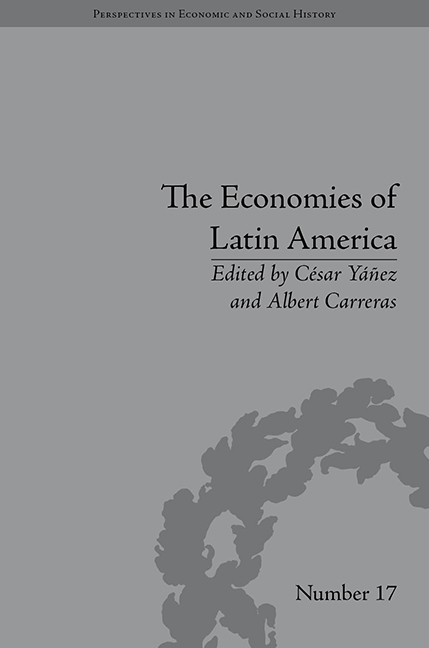Book contents
- Frontmatter
- CONTENTS
- List of Figures and Tables
- List of Contributors
- Preface
- Introduction: Latin American Economic Backwardness Revisited
- 1 Expectations, Institutions and Economic Performance: Latin America and the Western European Periphery during the Twentieth Century
- 2 On the Accuracy of Latin American Trade Statistics: A Non-Parametric Test for 1925
- 3 Latin America and Its Main Trade Partners, 1860–1930: Did the First World War Affect Geographical Patterns?
- 4 The Structure of Latin American Investment in Equipment Goods during the Mature Period of the First Globalization
- 5 Factorial Distribution of Income in Latin America, 1950–2000: New Series from the National Account Data
- 6 The Influence of the First World War on the Economies of Central America, 1900–29: An Analysis From a Foreign Trade Perspective
- 7 Economic Modernization in Adverse Institutional Environments: The Cases of Cuba and Chile
- 8 Capital Goods Imports, Machinery Investment and Economic Development in the Long Run: The Case of Chile
- 9 The Sugar Industry, the Forests and the Cuban Energy Transition, from the Eighteenth Century to the Mid-Twentieth Century
- 10 Empirical Debate on Terms Of Trade and the Double Factorial Terms of Trade of Colombia, 1975–2006
- 11 Public Revenues in Bolivia, 1900–31
- 12 The Consumption of Durable Goods in Latin America, 1890–1913: Analysis and Estimation of a Demand Function
- Notes
- Index
7 - Economic Modernization in Adverse Institutional Environments: The Cases of Cuba and Chile
- Frontmatter
- CONTENTS
- List of Figures and Tables
- List of Contributors
- Preface
- Introduction: Latin American Economic Backwardness Revisited
- 1 Expectations, Institutions and Economic Performance: Latin America and the Western European Periphery during the Twentieth Century
- 2 On the Accuracy of Latin American Trade Statistics: A Non-Parametric Test for 1925
- 3 Latin America and Its Main Trade Partners, 1860–1930: Did the First World War Affect Geographical Patterns?
- 4 The Structure of Latin American Investment in Equipment Goods during the Mature Period of the First Globalization
- 5 Factorial Distribution of Income in Latin America, 1950–2000: New Series from the National Account Data
- 6 The Influence of the First World War on the Economies of Central America, 1900–29: An Analysis From a Foreign Trade Perspective
- 7 Economic Modernization in Adverse Institutional Environments: The Cases of Cuba and Chile
- 8 Capital Goods Imports, Machinery Investment and Economic Development in the Long Run: The Case of Chile
- 9 The Sugar Industry, the Forests and the Cuban Energy Transition, from the Eighteenth Century to the Mid-Twentieth Century
- 10 Empirical Debate on Terms Of Trade and the Double Factorial Terms of Trade of Colombia, 1975–2006
- 11 Public Revenues in Bolivia, 1900–31
- 12 The Consumption of Durable Goods in Latin America, 1890–1913: Analysis and Estimation of a Demand Function
- Notes
- Index
Summary
Introduction
Unlike what occurred in the central zones of the Spanish Empire in America, the Cuban and Chilean economies grew and modernized from the end of the eighteenth century. The expansion rate of production oriented to export markets appears to have been a stimulus for the modernization of productive structures and institutions. From early on, fossil fuel consumption, mainly coal used in steam engines, adapted to the economic activities of Cuba and Chile. In the early nineteenth century, this was a powerful sign of the adaptation of modern technologies in peripheral economies. Cuba and Chile's lead position in the consumption of modern energies (coal, oil and hydroelectricity) throughout the nineteenth century was also related to the existence of an elite which was capable of generating a stable political order that favoured business and promoted institutional modernization, though without losing its oligarchic character. It was probably the oligarchic character of the political order which proved to be an obstacle to the conversion of economic growth into long term economic development.
Economic Modernization on the Periphery
In recent years, the explanation for the economic backwardness of Latin America has been based on three ideas which, despite their solidity, can be revised and enriched in the light of a study of the Cuban and Chilean experience. The first of these ideas suggests that adverse institutional situations, represented by the political chaos inherited from the wars of independence, would have been an insurmountable obstacle to social, political and economic modernization.
- Type
- Chapter
- Information
- The Economies of Latin AmericaNew Cliometric Data, pp. 105 - 118Publisher: Pickering & ChattoFirst published in: 2014



